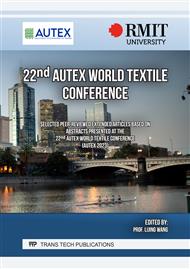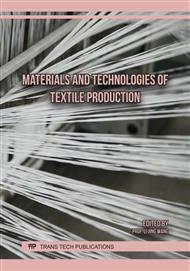[1]
Automotive Manufacturing Solutions: Thinking outside the box: lightweight battery enclosures. URL https://www.automotivemanufacturingsolutions.com/ev-battery-production/thinking-outside-the-box-lightweight-battery-enclosures/42124.article, accessed on: 11.10.23
Google Scholar
[2]
Flemming, M.; Ziegmann, G.; Roth, S.: Faserverbundbauweisen: Halbzeuge und Bauweisen. Berlin, Heidelberg: Springer Berlin Heidelberg, (1996)
DOI: 10.1007/978-3-642-61432-3_4
Google Scholar
[3]
Howell, E.; Geyer, C.: Interview with Christoph Geyer. In: Reinforced Plastics 63 (2019), Nr. 2, S. 76–78
DOI: 10.1016/j.repl.2017.12.070
Google Scholar
[4]
Kroll, L. (Hrsg.): Technologiefusion für multifunktionale Leichtbaustrukturen: Ressourceneffizienz durch die Schlüsseltechnologie "Leichtbau". Berlin, Germany: Springer Vieweg, (2019)
DOI: 10.1007/978-3-662-54734-2
Google Scholar
[5]
Minsch, N.; Nosrat-Nezami, F.; Gereke, T.; Cherif, C.: Review on Recent Composite Gripper Concepts for Automotive Manufacturing. In: Procedia CIRP 50 (2016), S. 678–682
DOI: 10.1016/j.procir.2016.04.175
Google Scholar
[6]
Minsch, N.; Müller, M.; Gereke, T.; Nocke, A.; Cherif, C.: 3D truss structures with coreless 3D filament winding technology. In: Journal of Composite Materials 53 (2019), Nr. 15, S. 2077–2089
DOI: 10.1177/0021998318820583
Google Scholar
[7]
Abounaim, M.; Cherif, Chokri: Flat-knitted innovative three-dimensional spacer fabrics: a competitive solution for lightweight composite applications. In: Textile Research Journal 82 (2012), Nr. 3, S. 288–298
DOI: 10.1177/0040517511426609
Google Scholar
[8]
Pfeiffer, J.: Leichtbau-Batteriepack verringert Gewicht und erhöht Reichweite von E-Autos. URL www.konstruktionspraxis.vogel.de/leichtbau-batteriepack-verringert-gewicht-und-erhoeht-reichweite-von-e-autos-a-974846/, accessed on: 11.10.23
Google Scholar
[9]
Mohammed, L.; Ansari, M. N. M.; Pua, G.; Jawaid, M.; Islam, M. S.: A Review on Natural Fiber Reinforced Polymer Composite and Its Applications. In: International Journal of Polymer Science 2015 (2015), S. 1–15
DOI: 10.1155/2015/243947
Google Scholar
[10]
Cherif, C. (Hrsg.): Textile materials for lightweight constructions: Technologies - methods - materials - properties. Berlin and Heidelberg and New York and Dordrecht and London: Springer, 2016 (Textile Materials for Lightweight Constructions)
DOI: 10.1007/978-3-662-46341-3
Google Scholar
[11]
Mohammadi, H.; Ahmad, Z.; Mazlan, S. A.; Faizal Johari, M. Aidy; Siebert, G.; Petrů, M.; Rahimian Koloor, S. S.: Lightweight Glass Fiber-Reinforced Polymer Composite for Automotive Bumper Applications: A Review. In: Polymers 15 (2022), Nr. 1
DOI: 10.3390/polym15010193
Google Scholar
[12]
Hohmann, A.: Ökobilanzielle Untersuchung von Herstellungsverfahren für CFK-Strukturen zur Identifikation von Optimierungspotentialen: Systematische Methodik zur Abschätzung der Umweltwirkungen von Fertigungsprozessketten. München. PhD thesis. (2019)
Google Scholar
[13]
Krieger, H.; Gries, T.; Stapleton, S. E.: Design of Tailored Non-Crimp Fabrics Based on Stitching Geometry. In: Applied Composite Materials 25 (2018), Nr. 1, S. 113–127
DOI: 10.1007/s10443-017-9603-y
Google Scholar
[14]
Lässig, R.; Eisenhut, M.; Mathias, A.; Schulte, R. T.; Peters, F.; Kühmann, T.; Waldmann, T.; Begemann, W.: Serienproduktion von hochfesten Faserverbundbauteilen: Perspektiven für den deutschen Maschinen- und Anlagenbau. In: Roland Berger Strategy Consultants (2012)
Google Scholar
[15]
Yang, C.; Nanni, A.; Dharani, L.: Effect of fiber misalignment on FRP laminates and strengthened concrete beams. In: 9th Int. Conf., Structural Faults and Repair, London, UK, (2001)
Google Scholar
[16]
Schürmann, H.: Konstruieren Mit Faser-Kunststoff-Verbunden. 2nd. Berlin: Springer-Verlag Berlin and Heidelberg GmbH & Co. KG, 2008 (VDI-Buch)
DOI: 10.1007/978-3-540-72190-1_14
Google Scholar
[17]
Nezami, F.: Automatisiertes Preforming von Kohlefaserhalbzeugen mit aktiven Materialführungssystemen zur Herstellung komplexer Faserverbundstrukturen. Dresden, Technische Universität Dresden. PhD thesis. (2015)
Google Scholar
[18]
Friese, D.; Scheurer, M.; Hahn, L.; Gries, T.; Cherif, C.: Textile reinforcement structures for concrete construction applications‐‐a review. In: Journal of Composite Materials 56 (2022), Nr. 26, S. 4041–4064
DOI: 10.1177/00219983221127181
Google Scholar
[19]
Albrecht, S.; Drechsler, K.; Hohmann, A.; Leistner, P.; Lindner, J. P.; Voringer, B.; Wehner, D.: Resource efficiency and environmental impact of fiber reinforced plastic processing technologies. In: Production Engineering 12 (2018), 3-4, S. 405–417
DOI: 10.1007/s11740-018-0802-7
Google Scholar
[20]
Hahn, L.: Prototype of a production technology for highly efficient manufacturing of performed textile. (ITMA 2019, spakers corner). Barcelona (Spain), 20.-26.06.(2019)
Google Scholar
[21]
Harrison, P. ; Yu, W-R. ; Long, A. C.: Modelling the deformability of biaxial non-crimp fabric composites. Elsevier, (2011)
DOI: 10.1533/9780857092533.2.144
Google Scholar
[22]
Horrocks, A. Richard; Anand, Subhash C.: Handbook of technical textiles. Amsterdam, Netherlands: Woodhead Publishing in association with The Textile Institute, 2016 (Woodhead Publishing Series in Textiles Ser v.1)
DOI: 10.1016/b978-1-78242-458-1.09989-1
Google Scholar
[23]
Hu, Jinlian (Hrsg.): 3-D fibrous assemblies: Properties, applications and modeling of three-dimensional textile structures. Cambridge, England and Boca Raton, FL: Woodhead Pub. in association with the Textile Institute, 2008 (Woodhead publishing in textiles no. 74)
DOI: 10.1016/b978-1-84569-377-0.50012-6
Google Scholar
[24]
Krieger, H.; Gries, T.; Stapleton, S. E.: Shear and drape behavior of non-crimp fabrics based on stitching geometry. In: International Journal of Material Forming 11 (2018), Nr. 5, S. 593–605
DOI: 10.1007/s12289-017-1368-1
Google Scholar
[25]
Schnabel, A.; Gries, T.: Production of non-crimp fabrics for composites. In: Non-Crimp Fabric Composites : Elsevier, 2011, S. 3–41
DOI: 10.1533/9780857092533.1.3
Google Scholar
[26]
Sankaran, V.: Development of a novel multiaxial warp knitting based technology for production of 3D near net shape preforms. Technische Universität Dresden and Verlag Dr. Hut. PhD thesis
Google Scholar
[27]
Hahn, L.; Zierold, K.; Golla, A.; Friese, D.; Rittner, S.: 3D textiles based on warp knitted three-dimensional fabrics: A review. In: Materials 16 (2023), Nr. 3680
DOI: 10.3390/ma16103680
Google Scholar
[28]
Sankaran, V.; Cherif, C.: New Machine Concept for Producing 3-D Stitch-Bonded Fabrics. In: Fibres & Textiles in Eastern Europe Nr 1 (97) (2013)
Google Scholar
[29]
Zierold, K.; Steinberg, J.; Hahn, L.; Rittner, S.; Friese, D.; Cherif, C.: Development of a method and technology for the production of 3D knitted reinforcement grids. In: Fibres & Textiles in Eastern Europe 151 (2022), Nr. 3, S. 18–26
DOI: 10.2478/ftee-2022-0018
Google Scholar
[30]
Teijin Carbon Europe GmbH: Tenax Filament Yarn. Datasheet. URL https://www.teijincarbon.com/de/produkte/tenaxr-kohlenstofffaser/tenaxr-filamentgarn, accessed on: 26.05.23
Google Scholar
[31]
Michler, H.: Gitterträger für Betontragwerke. Technische Universität Dresden, 01069, Dresden, DE. Registration number. 102016124226, Germany
DOI: 10.25368/2020.31
Google Scholar
[32]
Deutsches Institut für Bautechnik (DIBt): CARBOrefit® - Verfahren zur Verstärkung von Stahlbeton mit Carbonbeton, Z -31.10-182, Period of validity since (2014)
Google Scholar
[33]
CHT Germany GmbH: TECOSIT CC 1000. Datasheet. URL https://solutions.cht.com/cht/web.nsf/id/pa_tecosit-filmformers.html, accessed on: 11.10.23
Google Scholar
[34]
Hahn, L.; Rittner, S.; Nuss, D.; Ashir, M.; Cherif, C.: Development of Methods to Improve the Mechanical Performance of Coated Grid-Like Non-Crimp Fabrics for Construction Applications. In: Fibres and Textiles in Eastern Europe 27 (2019), 1(133), S. 51–58
DOI: 10.5604/01.3001.0012.7508
Google Scholar
[35]
Assing, H.; Borgwardt, H.; Stahl, A.: Von der COPRO-Technologie zum Hybridrollformprozess. In: Symposium Hybrider Leichtbau 2016.
Google Scholar
[36]
Friese, D.; Hahn, L.; Cherif, C.: Biologically Inspiried Load Adapted 3D Textile Reinforcement Structures. In: Materials Science Forum 1063 (2022), S. 101–110
DOI: 10.4028/p-8oa718
Google Scholar



